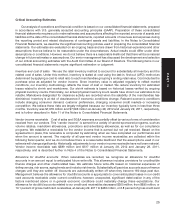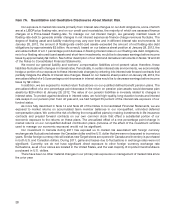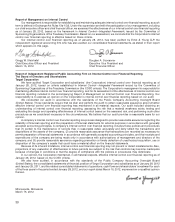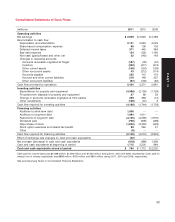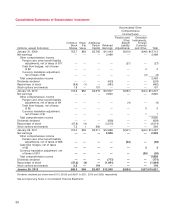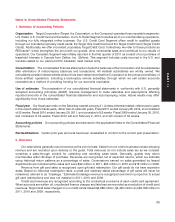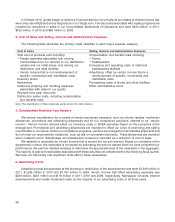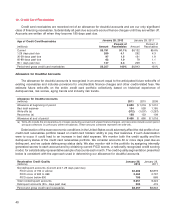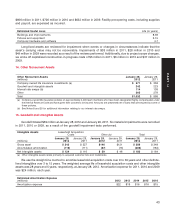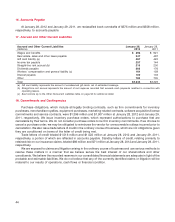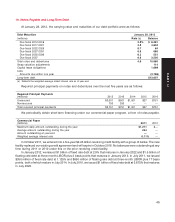Target 2011 Annual Report Download - page 59
Download and view the complete annual report
Please find page 59 of the 2011 Target annual report below. You can navigate through the pages in the report by either clicking on the pages listed below, or by using the keyword search tool below to find specific information within the annual report.
Notes to Consolidated Financial Statements
1. Summary of Accounting Policies
Organization Target Corporation (Target, the Corporation, or the Company) operates three reportable segments:
U.S. Retail, U.S. Credit Card and Canadian. Our U.S. Retail Segment includes all of our merchandising operations,
including our fully integrated online business. Our U.S. Credit Card Segment offers credit to qualified guests
through our branded proprietary credit cards; the Target Visa Credit Card and the Target Credit Card (Target Credit
Cards). Additionally, we offer a branded proprietary Target Debit Card. Collectively, we refer to these products as
REDcardsᓼ, which strengthen the bond with our guests, drive incremental sales and contribute to our results of
operations. Our Canadian Segment was initially reported in the first quarter of 2011 as a result of our purchase of
leasehold interests in Canada from Zellers, Inc. (Zellers). This segment includes costs incurred in the U.S. and
Canada related to our planned 2013 Canadian retail market entry.
Consolidation The consolidated financial statements include the balances of the Corporation and its subsidiaries
after elimination of intercompany balances and transactions. All material subsidiaries are wholly owned. We
consolidate variable interest entities where it has been determined that the Corporation is the primary beneficiary of
those entities’ operations, including a bankruptcy remote subsidiary through which we sell certain accounts
receivable as a method of providing funding for our accounts receivable.
Use of estimates The preparation of our consolidated financial statements in conformity with U.S. generally
accepted accounting principles (GAAP) requires management to make estimates and assumptions affecting
reported amounts in the consolidated financial statements and accompanying notes. Actual results may differ
significantly from those estimates.
Fiscal year Our fiscal year ends on the Saturday nearest January 31. Unless otherwise stated, references to years
in this report relate to fiscal years, rather than to calendar years. Fiscal 2011 ended January 28, 2012, and consisted
of 52 weeks. Fiscal 2010 ended January 29, 2011, and consisted of 52 weeks. Fiscal 2009 ended January 30, 2010,
and consisted of 52 weeks. Fiscal 2012 will end February 2, 2013, and will consist of 53 weeks.
Accounting policies Our accounting policies are disclosed in the applicable Notes to the Consolidated Financial
Statements.
Reclassifications Certain prior year amounts have been reclassified to conform to the current year presentation.
2. Revenues
Our retail stores generally record revenue at the point of sale. Sales from our online business include shipping
revenue and are recorded upon delivery to the guest. Total revenues do not include sales tax as we consider
ourselves a pass-through conduit for collecting and remitting sales taxes. Generally, guests may return
merchandise within 90 days of purchase. Revenues are recognized net of expected returns, which we estimate
using historical return patterns as a percentage of sales. Commissions earned on sales generated by leased
departments are included within sales and were $22 million in 2011, $20 million in 2010 and $18 million in 2009.
Revenue from gift card sales is recognized upon gift card redemption. Our gift cards do not have expiration
dates. Based on historical redemption rates, a small and relatively stable percentage of gift cards will never be
redeemed, referred to as ‘‘breakage.’’ Estimated breakage revenue is recognized over time in proportion to actual
gift card redemptions and was not material in 2011, 2010 and 2009.
Credit card revenues are recognized according to the contractual provisions of each credit card agreement.
When accounts are written off, uncollected finance charges and late fees are recorded as a reduction of credit card
revenues. Target retail sales charged on our credit cards totaled $4,686 million, $3,455 million and $3,328 million in
2011, 2010 and 2009, respectively.
35
PART II


